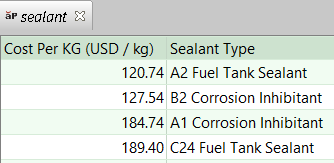Cap Sealing Options
The Cap Sealing process provides the following options:
Number of Holes Cap Sealed
By default, the number of cap-sealed holes is the sum of the following:
• Number of cap-sealed simple holes: this is the number of SimpleHole GCDs whose diameter is within range (see below).
• Number of cap-sealed complex holes: this is the number of ComplexHole GCDs whose MEC diameter (diameter of the largest circle that fits inside the hole) is in range.
A diameter or MEC diameter is in range if it is between the values of the following cost model variables:
• minRivetDiameter (2mm in starting point VPEs)
• maxRivetDiameter (8mm in starting point VPEs)
With this setup option, users can override the default number of cap-sealed holes.
The number of cap-sealed holes drives cycle time--see Cap Sealing Formulas.
Sealant Type
By default, sealant type is specified by the cost model variable defaultSealantType (B2 Corrosion Inhibitant in starting point VPEs). With this setup option, users can override the default, and select from the sealant types listed in the lookup table sealant.

Sealant type determines Sealant Price, by default, which drives costs for sealant material—see Additional Direct Costs in Cap Sealing Formulas.
Sealant Price
By default, sealant price is looked up by Sealant Type in the lookup table sealant. With this setup option, users can override the default.

Sealant price drives costs for sealant material—see Additional Direct Costs in Cap Sealing Formulas.
Time to Cap Seal One Hole
By default, the time to seal one hole is specified by the cost model variable defaultSealTime (5 seconds, in starting point VPEs). With this setup option, users can override the default. This value drives cycle time—see Cap Sealing Formulas.